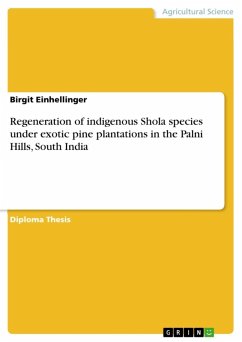Diploma Thesis from the year 2011 in the subject Forestry / Forestry Economics, grade: 2,0, University of Applied Sciences Weihenstephan, course: Forstwirtschaft, language: English, abstract: The Palani Hills or "Palni Hills" are situated in the western part of the state Tamil Nadu, South India (district Dindigul). The Palani Hills, (10°5' - 10°25' N and 77°15' - 77°50,E) are an eastward spur of the Western Ghats of India with a maximum (east to west) length of 65 km, a maximum width of 40 km (mean width 24 km) and a total area of 2068 km² (cf. Matthew,1999). The function of the Palni Hills as a critical water shade respectively as a catchment area and origin area of numerous streams is - ecological and economical - important for the whole population of Tamil Nadu, especially for the inhabitants of the planes. For several years now efforts have been made to "reserve forest land" (these forests are already among the protected areas of Tamil Nadu) to "Wildlife Sanctuary and National Park" as their upgrade will increase their IUCN status from level VI - Protected Area with Sustainable Use of Natural Resources to IV - Habitat/Species Management Area or II - National Park and improve the habitat and wildlife conservation of this area. IAN LOCKWOOD published 2003 in the Indian magazine "FRONTLINE": "In the early 1990s, the Tamil Nadu Forest Department submitted a proposal to the State government to protect much of the Palni Hills by declaring the area a wildlife sanctuary or a national park. The proposal was the result of a remarkable collaborative effort by the State Forest Department, the Palni Hills Conservation Council (PHCC) and several concerned individuals. Ten years later, the area still awaits the notification in this regard. In the meantime, mounting pressure on the habitat from encroachment and increased tourist inflow has taken its toll on the hills." Until today (2011) these efforts failed.
Dieser Download kann aus rechtlichen Gründen nur mit Rechnungsadresse in A, B, BG, CY, CZ, D, DK, EW, E, FIN, F, GR, HR, H, IRL, I, LT, L, LR, M, NL, PL, P, R, S, SLO, SK ausgeliefert werden.









